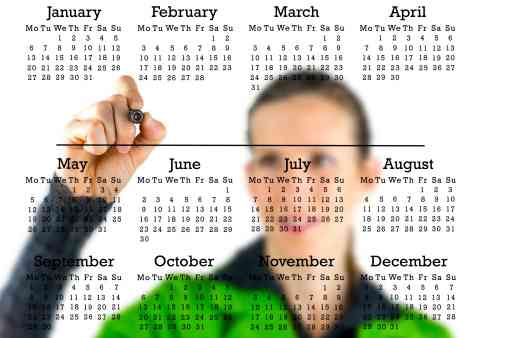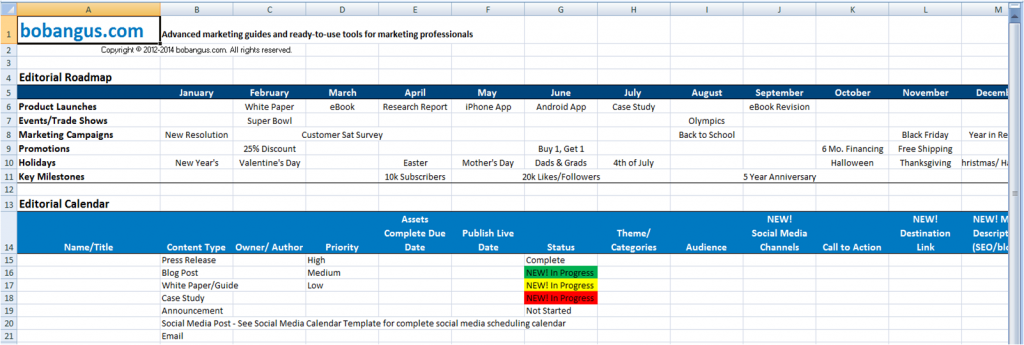Why every blog needs an editorial calendar
 Many of the clients we work with understand the benefits of having a blog. Most, however, haven’t embraced developing an editorial calendar. That’s a huge mistake.
Many of the clients we work with understand the benefits of having a blog. Most, however, haven’t embraced developing an editorial calendar. That’s a huge mistake.
Assigning bloggers to specific days, thereby creating an editorial calendar, makes many bloggers nervous. You want the freedom and flexibility to write when it’s convenient for you – we understand that. However, an editorial calendar has benefits that cannot be overlooked.
Ensure frequency
An editorial calendar ensures you have a minimum number of posts per week. According to a study by HubSpot, companies that post more than 15 blogs per month receive five times more traffic on their website than companies that don’t blog at all. If you have a smaller team of writers — or maybe it’s just you — 15 posts per month might not be a reasonable goal. However, the same study showed companies that increase blogging from three to five times per month to six to eight times per month almost double their leads.
Consistency is key
Hopefully your blog is attracting repeat readers. People are more likely to return if they find new content each time they check your website or at least know when to expect posts (i.e., you post every Tuesday and Thursday).
Without an editorial calendar, you could end up with two blog posts by different bloggers on the same day and then no new content for a week or two. If an interested reader checks in and repeatedly finds no new content, they’re likely to stop visiting your site.
Consistently adding new content to your blog is also crucial to improving your ranking on search engines.
Improve your strategic approach
Whether you’ve created an editorial board and developed buyer personas or simply started a blog, at some level you’ve probably developed a content marketing strategy with your blog. An editorial calendar will help you enact that strategy by allowing you to track your content. Are you addressing all of your relevant buyer personas? Are you providing information relevant to those buyer personas?
As you can see below in the template examples, more detailed editorial calendars can allow you to track how your content is matching up with your target audience, your use of keywords, calls-to-action and more. Using this type of editorial calendar will assist you in your future planning and ensure you’re enacting your content marketing strategy and not simply throwing words out into the void.
You can still be flexible
Your bloggers don’t have to give up freedom and flexibility. If they need to miss their assigned day, they can trade with another blogger. If that doesn’t work, missing a day here or there isn’t the end of the world. The opposite is also true: if bloggers want to post more often than they are assigned, that’s great.
What does an editorial calendar look like?
An editorial calendar can be as simple as a spreadsheet with dates and the names of bloggers assigned to those dates. If you want to get the most out of your editorial calendar, however, we recommend something a little more robust that covers your entire content marketing plan. It will take a little more time to develop, but it can also ensure your blog and other content is efficiently and effectively working toward targeted results.
There are numerous templates out there to assist you in building an editorial calendar. My personal favorite is this one from Bob Angus, which I’m currently using with an international B2C client.
Here are the features I like about this template:
-
The Editorial Roadmap at the top of the first worksheet is a big picture overview of the year that allows both the client and me to plan in advance for holidays and company promotions, ensuring plenty of time for blogs, social media campaigns and media pitches.
-
The more detailed month-by-month Editorial Calendar that follows allows us to plan the specific content for each month, whether that’s a blog post, social media campaign, video series or advertisement.
-
The detailed breakdown also allows us to keep track of basic information such as who is working on which project, the date materials are due and when we’re going live.
-
If you’ve developed buyer personas (which we highly encourage), this calendar also allows you to track your target audience and ensure your content marketing efforts are targeted. You may also realize you’re addressing one buyer persona more or less often than the others, which will allow you to adjust future content.
-
Calls-to-action can also be documented in this worksheet.
-
Additionally, we track hashtags we have planned for social media campaigns within this worksheet and which pieces of content are part of those campaigns.
-
There is a second worksheet on the next tab of this workbook that allows you to track future ideas that haven’t been assigned a date yet. My client simply forwards me a tweet or an email that sparked an idea, and I log it here until we get the chance to plug it into a specific date or campaign.
Find what works for you
Everyone is going to have different preferences, so I encourage you to download several templates and play around with them a little to see which makes the most sense to you and your team. Here are links to several you can try:
-
Template from Bob Angus (the one I described above)
-
Template from HubSpot
-
Template from Brett A. Snyder
Curata has the ultimate list of editorial calendar templates here, comparing them side-by-side and providing images of each.
Your editorial calendar can be as simple or complex as you want to make it. The most important part is getting started.








